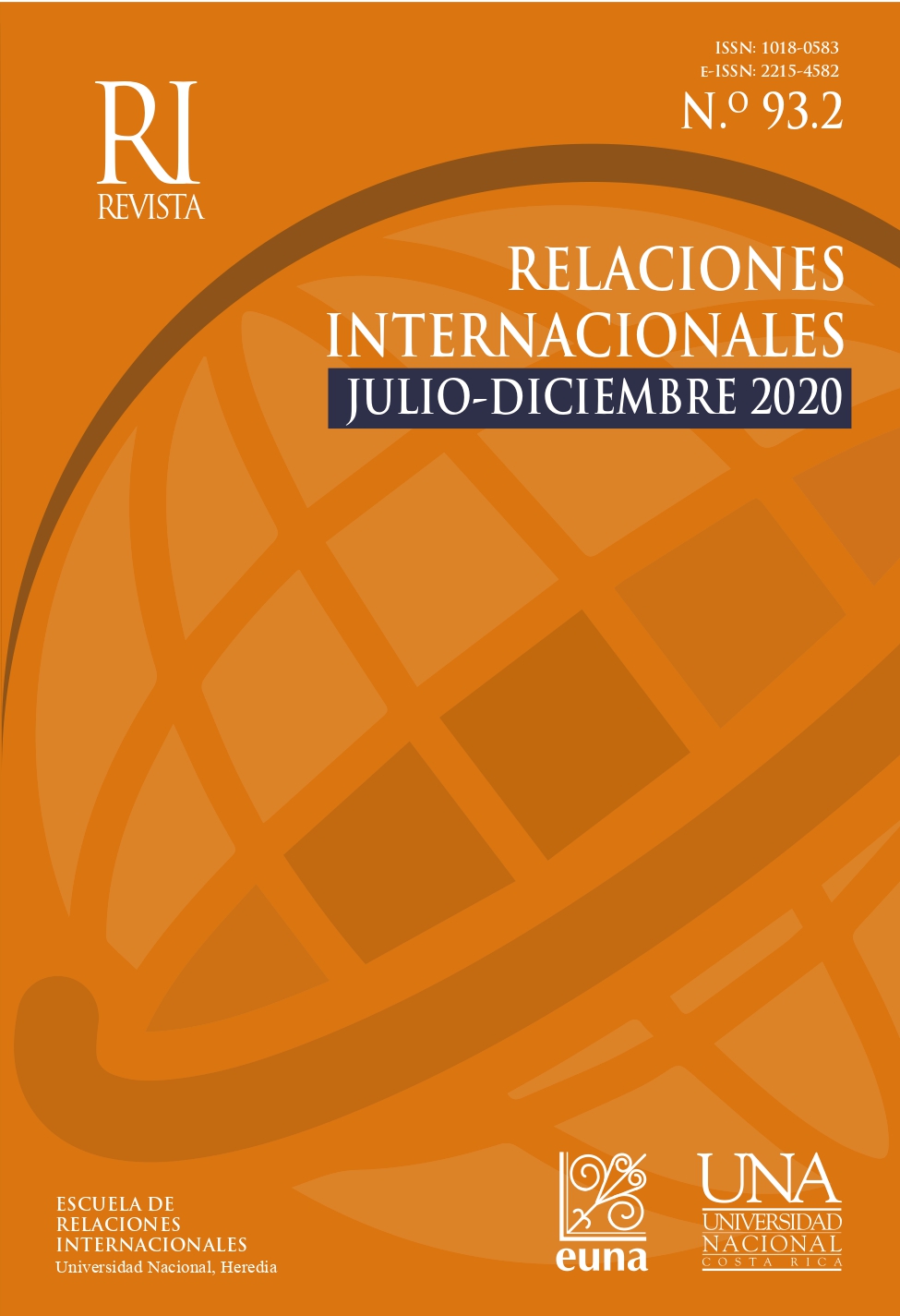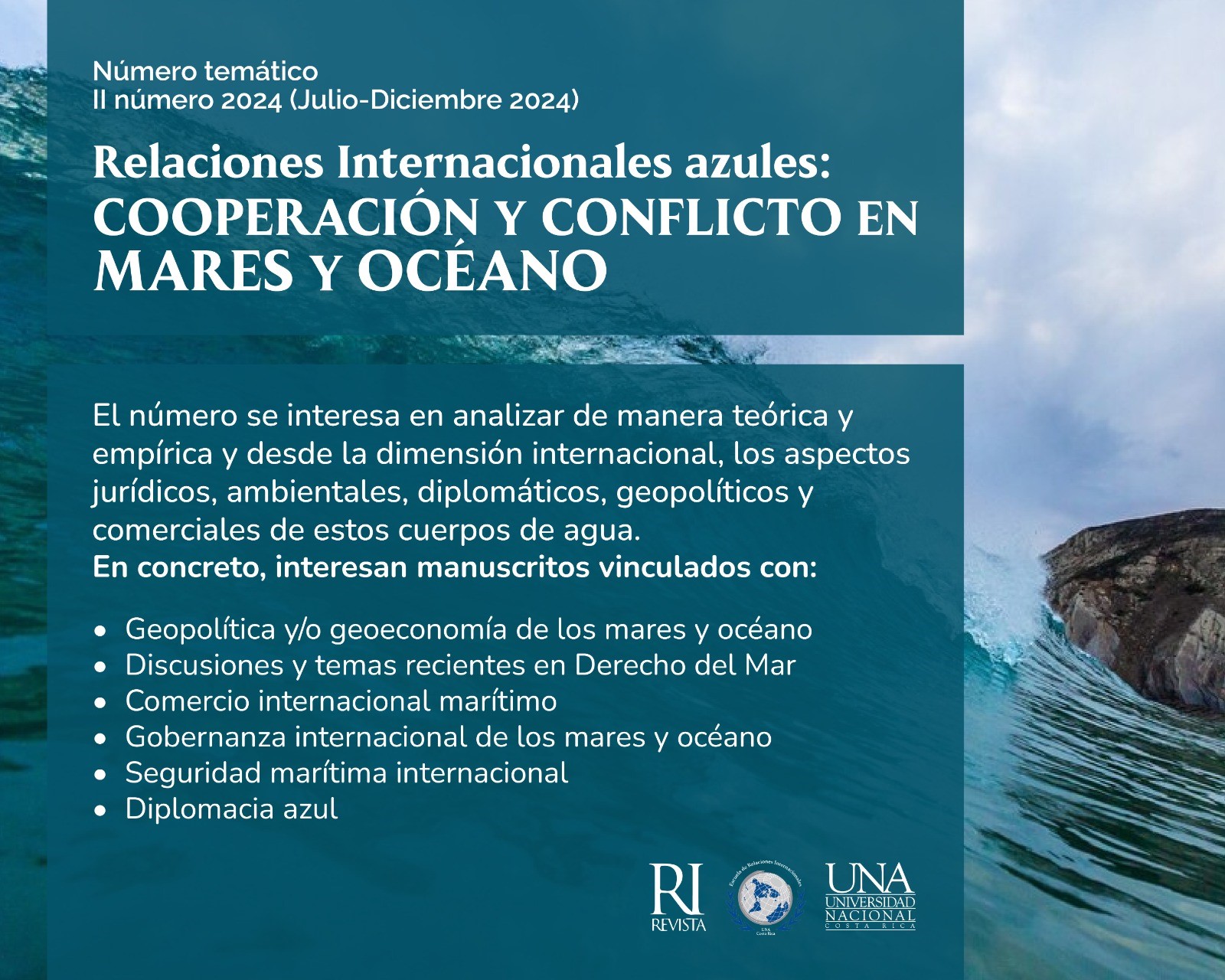Análisis de la política exterior de Xi Jinping hacia el Sudeste de Asia: Estrategias, intereses y dimensiones
DOI:
https://doi.org/10.15359/ri.93-2.4Palabras clave:
Política exterior china, asertividad, ASEAN, Mar de China Meridional, Nueva Ruta de la SedaResumen
El presente trabajo analiza la política exterior de Xi Jinping hacia el Sudeste de Asia, focalizando en las dimensiones político-estratégica y económica. Se toma como premisa, coincidiendo con una extensa línea de estudios, que sus acciones y estrategias muestran mayor visibilidad y dinamismo que las ejecutadas por sus antecesores, tanto a nivel regional como global.
A partir de la revisión bibliográfica se identifica que China combina, por un lado, una política exterior asertiva en cuestiones de soberanía territorial, como la defensa de su soberanía marítima en el Mar de China Meridional y; por el otro, la integración económica y comercial basada en la interdependencia y el multilateralismo, a través del fortalecimiento de los lazos regionales en el marco de la ASEAN+3, el Área de Libre Comercio China-ASEAN y la Belt and Road Initiative.
Este artículo se centra en la complementariedad de las acciones e iniciativas de la política exterior china hacia la región, a partir del desarrollo de una estrategia holística de proyección global, basada en la consolidación de un espacio regional de poder y la consecuente construcción de liderazgo.
Referencias
Arase, D. (2016). The geopolitics of Xi Jinping’s Chinese dream: problems and prospects. ISEAS-Yusof Ishak Institute.
ASEAN. (2012, 12 de octubre). Declaration on the conduct of the Parties in the South China Sea. https://asean.org/?static_post=declaration-on-the-conduct-of-parties-in-the-south-china-sea-2
ASEAN-China Center. (2013, 2 de octubre). Speech by Chinese President Xi Jinping to Indonesian Parliament. http://www.asean-china-center.org/english/2013-10/03/c_133062675.htm
ASEAN Secretariat Information Paper. (2017). Overview of ASEAN Plus Three Cooperation. https://asean.org/storage/2017/06/Overview-of-APT-Cooperation-Jun-2017.pdf
ASEAN Stats. (2020). ASEAN Stats Data Portal. https://data.aseanstats.org/
Ba, A. (2014). Is China leading? China, Southeast Asia and East Asian integration. Political Science, 66(2), 143–165.
Baviera, A. (2016). China’s strategic foreign initiatives under Xi Jinping. China Quarterly of International Strategic Studies, 2(1), 57-79.
Beeson, M. (2013). Living with Giants: ASEAN and the Evolution of Asian Regionalism. TRaNS: Trans -Regional and -National Studies of Southeast Asia, 1(2), 303-322.
Cai, K. (2003). The ASEAN-China free trade agreement and East Asian regional grouping. Contemporary Southeast Asia, 25(3), 387-404.
Callahan, W. (2016). China’s “Asia Dream.” Asian Journal of Comparative Politics, 1(3), 226–243.
Chang Liao, N. (2018). Domestic Politics and China’s Assertive Foreign Policy: Why China’s Rise May Not Be Peaceful. En T. Leng y R. Aoyama (Eds.), Decoding the Rise of China (pp. 85-106). Palgrave Macmillan.
Chen, D., Pu, X., y Jonhston, A. I. (2014). Debating China’s Assertiveness. International Security, 38(3), 176–183.
Christensen, T. (2012). The Advantages of an Assertive China: Responding to Beijing’s Abrasive Diplomacy. Foreign Affairs, 90(2), 54–67.
Clinton, H. (2010, 23 de julio). Remarks at the ARF Meeting. National Convention Center Hanoi, Vietnam. https://20092017.state.gov/secretary/20092013clinton/rm/2010/07/145095.htm
Dai Binguo (2010, 6 de diciembre). Adhere To The Path Of Peaceful Development. http://china.usc.edu/dai-bingguo-%E2%80%9Cadhere-path-peaceful-development%E2%80%9D-dec-6-2010
Das, S. (2018). Do the economic ties between ASEAN and China affect their strategic partnership? ISEAS Perspective, 32. Yusof-Ishak Institute.
Delage, F. (2013). La República Popular China y la reconfiguración del orden asiático (1997-2005). Universidad Complutense E-Prints. http://eprints.ucm.es/24641/1/T35175.pdf.
Delage, F. (2015). La estrategia asiática de Xi Jinping. Revista del Instituto Español de Estudios Estratégicos, 5, 1-36.
Fravel, M. (2011). China’s Strategy in the South China Sea. Contemporary Southeast Asia 33(3), 292–319.
Friedberg, A. (2015). The Debate Over US China Strategy. Survival, 57(3), 89–110.
Greitens, S. (2013, 11 de junio). US-China relations and America’s alliances in Asia. Brooking Opinion. https://www.brookings.edu/opinions/u-s-china-relations-and-americas-alliances-in-asia/
González Saez, R. (2017, 25 de junio). XXXI Cumbre de ASEAN: La brújula se mueve hacia China. Observatorio de la Política China. https://politica-china.org/areas/politica-exterior/xxxi-cumbre-de-asean-la-brujula-se-mueve-hacia-china
Haacke, J. (2002). Seeking influence: China’s diplomacy towards ASEAN after the Asian crisis. Asian perspective, 26(4), 13-52.
Hernández Pedraza, G. (2005). Evolución actual y perspectivas de las relaciones China-ASEAN. En La economía mundial y América Latina. Tendencias, problemas y desafíos (pp. 107-136). Consejo Latinoamericano de Ciencias Sociales. http://biblioteca.clacso.edu.ar/clacso/gt/20101013123724/5ParteI4.pdf
Hiep, L. H. (2015)- Vietnam’s Alliance Politics in the South China Sea. Trends of Southeast Asia 6, ISEAS, 1–27.
Hoang, T. (2019). From Declaration to Code: Continuity and Change in China’s Engagement with ASEAN on the South China Sea. Trends in Southeast Asia. ISEAS.
International Trade Center [ITC] (2019). Trade Map. https://www.trademap.org/
Johnston, A. (2013). How New and Assertive Is China’s New Assertiveness? International Security, 37(4), 7-48.
Khan, S. y Yu, L. (2013). Evolving China–ASEAN Relations and CAFTA: Chinese Perspectives on China’s Initiatives in Relation to ASEAN Plus 1. European Journal of East Asian Studies, 12, 81–107.
Kissinger, H. (2012). China. Debate.
Kraft, H. J. S. (2017). Great Power Dynamics and the Waning of ASEAN Centrality in Regional Security. Asian Politics & Policy, 9(4), 597–612.
Kuik, C. (2005). Multilateralism in China’s ASEAN policy: its evolution, characteristics, and aspiration 2006. Contemporary Southeast Asia, 27(1), 102-122.
La Voz de Vietnam. (2020, 14 de abril). Concluye la Cumbre Especial de la Asean+3 sobre el Covid-19. https://vovworld.vn/es-ES/noticias/concluye-la-cumbre-especial-de-la-asean3-sobre-el-covid19-848387.vov
Leifer, M. (1994). Expanding horizons in Southeast Asia? In Southeast Asian affairs 1994 (pp. 3-21). Institute for Southeast Asian Studies.
Leifer, M. (1995). Dictionary of the modern politics of South-east Asia. Routledge.
Li, M. (2009). Cooperation for Competition: China’s Approach to Regional Security in East Asia. Panorama: Insights into Asian and European Affairs, 2, 121-134.
Lye, L. F. y Ha, H. H. (2018). Vietnam’s responses to China’s maritime assertiveness in the South China Sea. Perspective, 50.
Mayer, M. (2018). China’s historical statecraft and the return of history. International Affairs, 94(6),1217-1236.
Mearsheimer, J (2014, 25 de octubre). Can China Rise Peacefully? The National Interest. https://nationalinterest.org/print/commentary/can-china-rise-peacefully-10204
Miks, J. (2012, 11 de abril). China, Philippines in Standoff. The Diplomat. https://thediplomat.com/2012/04/china-philippines-in-standoff/
Nie, W. (2016). Xi Jinping’s foreign policy dilemma. Contemporary Southeast Asia, 38(3), 422-444.
Nolan, P. (2019). “Preface”. En C. Fang, y P. Nolan, (Eds.), Routledge Handbook of the Belt and Road (pp. xxi-xxiv). Routledge.
Norris, W. (2010). Economic Statecraft with Chinese Characteristics: The Use of Commercial Actors in China’s Grand Strategy. Princeton University Press.
Norton, S. (2015). China’s grand strategy. China Studies Centre, University of Sydney. http://sydney.edu.au/china_studies_centre/images/content/ccpublications/policy_paper_series/2015/chinas-grand-strategy.pdf
Pu, X. (2017). Controversial Identity of a Rising China. The Chinese Journal of International Politics, 10(2), 131–149.
Qin, Y. (2014). Continuity through Change: Background Knowledge and China’s International Strategy. Chinese Journal of International Politics, 7(3), 285–314
Reilly, J. (2013). China’s economic statecraft: turning wealth into power. Analysis. Lowy Institute for International Policy, Sidney. https://www.files.ethz.ch/isn/175042/reilly_chinas_economic_statecraft_web.pdf
Roberts, C. (2018). The South China Sea Precedent: Rising Instability Amidst Revisionist Tendencies. RSIS Commentaries. Nanyang Technological University, Singapore.
Rocha Pino, M. (2020). La proyección de la Iniciativa Cinturón y Ruta de la Seda en la Unión Europea (2014-2019): Implicaciones económicas y normativas. Relaciones Internacionales, 93(2), 19-46.
Rubiolo, M. F. (2020). The South China Sea Dispute: Reflection of Southeast Asia’s Economic and Strategic Dilemmas (2009-2018). Revista Relaciones Internacionales, Estrategia y Seguridad, 15(2), 115-130.
Rubiolo, F. (2010). Política exterior china hacia los procesos de integración regional de Asean: El foro regional de Asean y Asean Plus Three. Astrolabio, 5, 160-184.
Saunders, P. (2013). The Rebalance to Asia: U.S.-China Relations and Regional Security. Strategic Forum, 281, 1-16.
See Seng, T. (2016). Multilateral Asian Security Architecture: Non-ASEAN Stakeholders. Routledge.
Severino, R. (2010). ASEAN and the South China Sea. Security Challenges, 6(2), 37-47.
Shih C., y Yin, J. (2013). Between Core National Interest and a Harmonious World: Reconciling Self-role Conceptions in Chinese Foreign Policy. The Chinese Journal of International Politics, 6, 59–84.
Soong, J. (2016) The Political Economy of Development Between China and the ASEAN States: Opportunity and Challenge. The Chinese Economy, 49, 395-399.
Southgate, L. y Khoo, N. (2016). Enter the vanguard state: Reinterpreting ASEAN’s response to the South China Sea issue. Journal of Asian Security and International Affairs, 3(2), 221–244.
Storey I. (2018). ASEAN’s Failing Grade in the South China Sea. En G. Rozman y J. Liow (Eds.), International Relations and Asia’s Southern Tier (pp. 111-124). Macmillan Series.
Swaine, M. (2010). Perceptions of an Assertive China. China Leadership Monitor, 32, 1-19.
Vélez Serrano, M. (2018). De dragón revolucionario, a tímido, y ahora rejuvenecido. Relaciones Internacionales, 91(2), 1-23.
Wong, L. (2007). China-ASEAN and Japan-ASEAN relations during the Post-Cold War era. Chinese Journal of International Politics 1, 373-404.
Xi, J. (2017, 3 de noviembre). Informe presentado ante el XIX Congreso Nacional del Partido Comunista Chino. Beijing, China.
Xi, J. (2015, 28 de setiembre). Working Together to Forge a New Partnership of Win-win Cooperation and Create a Community of Shared Future for Mankind. Discurso presentado ante la 70° sesión de la Asamblea General de Naciones Unidas. Nueva York, Estados Unidos.
Xinhua (2019a, 9 de septiembre). China y ASEAN reforzarán relaciones económicas y comerciales. http://spanish.xinhuanet.com/2019-09/10/c_138379062.htm
Xinhua (2019b, 22 de septiembre). Los lazos entre China y la ASEAN cosechan con visión compartida. https://www.chinadailyhk.com/articles/179/131/119/1569159780799.html?newsId=106764
Xue Gong. (2019). The Belt & Road Initiative and China’s influence in Southeast Asia, The Pacific Review, 32(4), 635-665.
Yahuda, M. (2013). China’s new assertiveness in the South China Sea. Journal of Contemporary China, 22(81), 446-459.
Yan, X. (2014). From keeping a low profile to striving for achievement. the chinese Journal for International Politics, 7(2), 153-184.
Yang, J. (2010). ‘Response and Responsibility: China in East Asian Financial Cooperation’, Pacific Review, 23(5), 603–623.
Yang, F. y Li, M. (2016). Comparing China’s Claims and Policies in the East and South China Seas: Implications for Regional Security. Journal of Asian Security and International Affairs, 3(2), 135–156.
Zhang, D. (2018). The Concept of ‘Community of Common Destiny’ in China’s Diplomacy: Meaning, Motives and Implications. Asia & the Pacific Policy Studies 5, 1-12.
Zhang, B. (2015a). Chinese Perceptions of US Return to Southeast Asia and the Prospect of China’s Peaceful Rise. Journal of Contemporary China, 24(91), 176-195.
Zhang, C. (2013). Historical Changes in Relations Between China and Neighboring Countries (1949–2012). Asia Paper, Institute for Security and Development Policy.
Zhang, F. (2012). Rethinking China’s grand strategy: Beijing’s evolving national interests and strategic ideas in the reform era. International Politics, 49(3), 318–345.
Zhang, J. (2015). China’s new foreign policy under Xi Jinping: towards ‘Peaceful Rise 2.0’. Global Change. Peace & Security, 27(1), 5-19.
Zhang, X. (2006). The rise of China and community building in East Asia. Asian Perspective, 30(3), 129-148.
Publicado
Cómo citar
Número
Sección
Licencia
Esta publicación está adscrita a Creative Commons; deben respetarse sus atribuciones y restricciones.
Los autores/as que publiquen en esta revista aceptan las siguientes condiciones:
- Los autores/as conservan los derechos de autor y ceden a la revista el derecho de la primera publicación, con el trabajo registrado con la Licencia Creative Commons Atribución-NoComercial-CompartirIgual 4.0 Internacional, que permite a terceros utilizar lo publicado siempre que mencionen la autoría del trabajo y a la primera publicación en esta revista.
- Los autores/as pueden realizar otros acuerdos contractuales independientes y adicionales para la distribución no exclusiva de la versión del artículo publicado en esta revista (p. ej., incluirlo en un repositorio institucional o publicarlo en un libro) siempre que indiquen claramente que el trabajo se publicó por primera vez en esta revista.
- Se permite y recomienda a los autores/as a publicar su trabajo en Internet (por ejemplo en páginas institucionales o personales) antes y durante el proceso de revisión y publicación, ya que puede conducir a intercambios productivos y a una mayor y más rápida difusión del trabajo publicado.
Revista de Relaciones Internacionales por Universidad Nacional de Costa Rica está bajo una Licencia Creative Commons Atribución-NoComercial-SinDerivar 4.0 Internacional









.png)



2.png)
